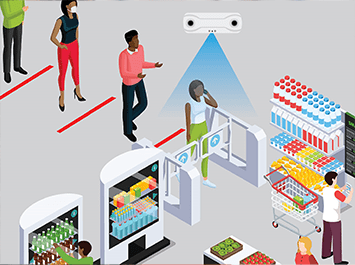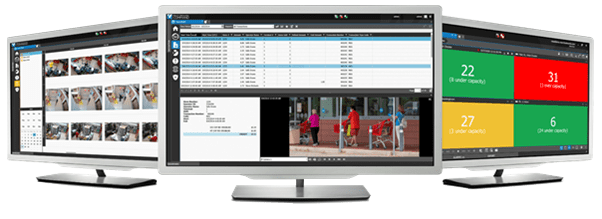
Health Compliance in retail
28 July 2020
I was inspired to write this article by an event that took place in one of the village shops belonging to the TopMarket chain.
In a hurry, I jumped out of the car to do some quick shopping. In a hurry, so without my face shield, which, by the way, I have been always keeping in my car recently (I recommend it, it is more comfortable than a mask). I approached the gate and was surprised… the gate did not open. There was a notice saying that it was forbidden to enter the shop premises without a mask. I lifted my gaze, looking at the ceiling, and of course, I noticed a camera pointed at the entrance.
I obediently walked back for my shield, curious how the system (because I don’t have to add that the gate wasn’t operated by a person…) will react to it. Of course, it reacted, as it should – the gate opened, and I walked in.
It was then that I realized that the technical solutions, which make it easier to maintain the sanitary regime, were appearing on the market very slowly, and I myself, for the first time, had an opportunity to test them during my usual daily shopping. Perhaps retailers are counting on the epidemic ending soon and they simply don’t want to spend money on such solutions or maybe they haven’t seen their great potential yet. In any case, this market segment is still underdeveloped. And that’s a shame.
In an interesting article by Professor Robert Flisiak for OKO.press I read one of the wiser thoughts about COVID-19, which I also take the liberty of quoting here in full:
“We should stop thinking in terms of “we’re afraid”, “fear”. We have no choice but to learn to live with this virus. If we can’t get it to adapt to us, we have to adapt to this situation. That’s why we have to accept the risk of infection. The point is to individualize it at a personal level and minimize it at both individual and global levels”.
According to this statement, using the opportunities offered by technology in the so-called “new reality” should be a completely natural turn of events for us.
Solutions based on camera image analysis are no rocket-science nowadays. What’s more, there is even a pretty neat term for them – health compliance. On the one hand, they help to identify certain irregularities or situations of increased risk (e.g. customer’s fever, the fact of not washing hands, lack of disinfection of a table or a hotel room, exceeding the allowed number of people in a shop or cinema, lack of helmet or, as in the case mentioned at the beginning, mask or face shield). On the other hand, they help to take automatic action, e.g. send an alert by e-mail or text message, light an alarm signal (e.g. Philips Hue bulb) or even not open the shop gate. What is more, they also enable the analysis of such events from the past, which facilitates making the right decisions after the epidemic risk becomes real.
Such systems monitor and measure traffic in real-time with 99% accuracy and ensure that current governmental health, safety, and general retail operation regulations are easier to enforce. Their use allows to provide a safe shopping environment with exemplary customer service, suitable for operation even in such difficult conditions as at present.

The author of the article is Bartłomiej Łatka, an expert on retail and logistics.